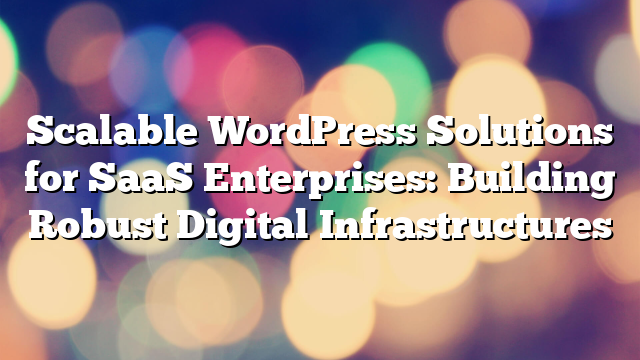How Headless WordPress Boosts Enterprise Website Performance
18.11.2024

In the fast-paced world of enterprise websites, delivering exceptional performance and user experience is paramount. Traditional WordPress, while powerful, may face limitations when handling complex, high-traffic sites. This is where Headless WordPress shines. By decoupling the front-end from the back-end, Headless WordPress provides enterprises with the flexibility and speed needed to excel in today’s competitive digital landscape. In this article, we’ll explore how Headless WordPress enhances website performance and why it’s an ideal solution for enterprise needs.
What is Headless WordPress?
Headless WordPress separates the back-end content management system (CMS) from the front-end presentation layer. In this setup, WordPress serves purely as a back-end for content storage and management, while the front-end is built using modern JavaScript frameworks like React, Angular, or Vue.js. Communication between the two is handled through REST APIs or GraphQL, allowing enterprises to deliver highly dynamic and performant websites.
Key Performance Benefits of Headless WordPress
1. Blazing-Fast Loading Speeds
One of the most significant advantages of Headless WordPress is the ability to achieve lightning-fast loading speeds. Modern front-end frameworks used in headless architecture are optimized for performance and deliver content in a highly efficient manner. By leveraging techniques like server-side rendering (SSR) or static site generation (SSG), enterprises can ensure their websites load almost instantaneously, improving user satisfaction and reducing bounce rates.
2. Scalability for High-Traffic Websites
For enterprises handling large volumes of traffic, scalability is critical. Traditional WordPress can experience performance bottlenecks under heavy load, particularly when serving dynamic content. Headless WordPress decouples content delivery from the WordPress back-end, allowing enterprises to use content delivery networks (CDNs) and caching strategies to serve pre-rendered pages. This approach significantly reduces server strain, enabling websites to handle high traffic seamlessly.
3. Enhanced User Experience
Headless WordPress empowers developers to create highly interactive and visually engaging user experiences. By utilizing modern front-end technologies, enterprises can implement features like infinite scrolling, real-time data updates, and smooth transitions, which are challenging to achieve with traditional WordPress. A superior user experience translates to higher engagement, increased conversions, and a competitive edge.
4. Improved Mobile Performance
With mobile usage dominating the digital landscape, ensuring optimal mobile performance is essential. Headless WordPress enables developers to build responsive, mobile-first websites using JavaScript frameworks designed for performance. Features like progressive web apps (PWAs) and adaptive design further enhance mobile usability, making it easier for enterprises to cater to their on-the-go audiences.
Flexibility and Customization for Enterprises
1. Freedom to Choose Front-End Technologies
Headless WordPress gives enterprises the freedom to select the best front-end technologies for their needs. Whether it’s React for dynamic interfaces, Next.js for static site generation, or Angular for robust enterprise solutions, the flexibility to choose ensures that the front-end aligns perfectly with business goals and technical requirements.
2. Seamless Multi-Channel Content Delivery
Enterprises often need to deliver content across multiple channels, including websites, mobile apps, and digital signage. Headless WordPress facilitates multi-channel publishing by delivering content via APIs. This ensures consistency across platforms and allows enterprises to reach their audiences wherever they are, from smartphones to IoT devices.
3. Tailored Performance Optimization
Traditional WordPress sites often rely on themes and plugins, which can introduce unnecessary bloat. With Headless WordPress, enterprises can build lean, custom front-ends tailored to their performance goals. By eliminating unused features and optimizing code, developers can deliver a streamlined user experience that prioritizes speed and efficiency.
Challenges and Considerations
1. Increased Development Complexity
While Headless WordPress offers significant benefits, it also introduces increased complexity. Building and maintaining a separate front-end requires specialized knowledge of JavaScript frameworks and API integrations. Enterprises must have skilled developers or work with experienced agencies to ensure the success of a headless project.
2. Initial Setup Costs
The transition to Headless WordPress can involve higher initial costs compared to traditional WordPress setups. Enterprises need to invest in front-end development, hosting infrastructure, and potential API-related expenses. However, these costs are often outweighed by the long-term performance gains and scalability benefits.
3. Dependence on APIs
Headless WordPress relies heavily on APIs to connect the back-end and front-end. Any issues with API performance or availability can impact the website’s functionality. Enterprises should implement robust monitoring and failover strategies to mitigate risks associated with API dependencies.
Best Practices for Implementing Headless WordPress
1. Optimize API Performance
Efficient API performance is crucial for a successful headless implementation. Enterprises should use caching layers, minimize API calls, and adopt GraphQL for faster, more flexible data fetching. These strategies help ensure that content is delivered quickly and reliably.
2. Leverage CDNs for Faster Delivery
Content Delivery Networks (CDNs) are a key component of headless architecture. By distributing content to servers worldwide, CDNs reduce latency and ensure fast delivery to users regardless of their location. This is particularly important for global enterprises serving diverse audiences.
3. Prioritize Security
Decoupled architectures introduce new security considerations, such as securing API endpoints and protecting the back-end from unauthorized access. Enterprises should implement robust security measures, including authentication tokens, HTTPS protocols, and firewalls, to safeguard their data and systems.
4. Test Across Devices and Platforms
Since Headless WordPress often delivers content across multiple platforms, thorough testing is essential. Enterprises should test their websites and applications on various devices, browsers, and network conditions to ensure consistent performance and user experience.
Conclusion
Headless WordPress is a game-changer for enterprises looking to enhance website performance, scalability, and flexibility. By separating the front-end and back-end, enterprises can create dynamic, high-performing websites that cater to modern user expectations. While the transition to headless architecture involves challenges, the benefits far outweigh the drawbacks for businesses aiming to stay competitive in a rapidly evolving digital landscape.
Ready to take your enterprise website to the next level? Contact AllWebDev for expert guidance on implementing Headless WordPress solutions tailored to your business needs.



